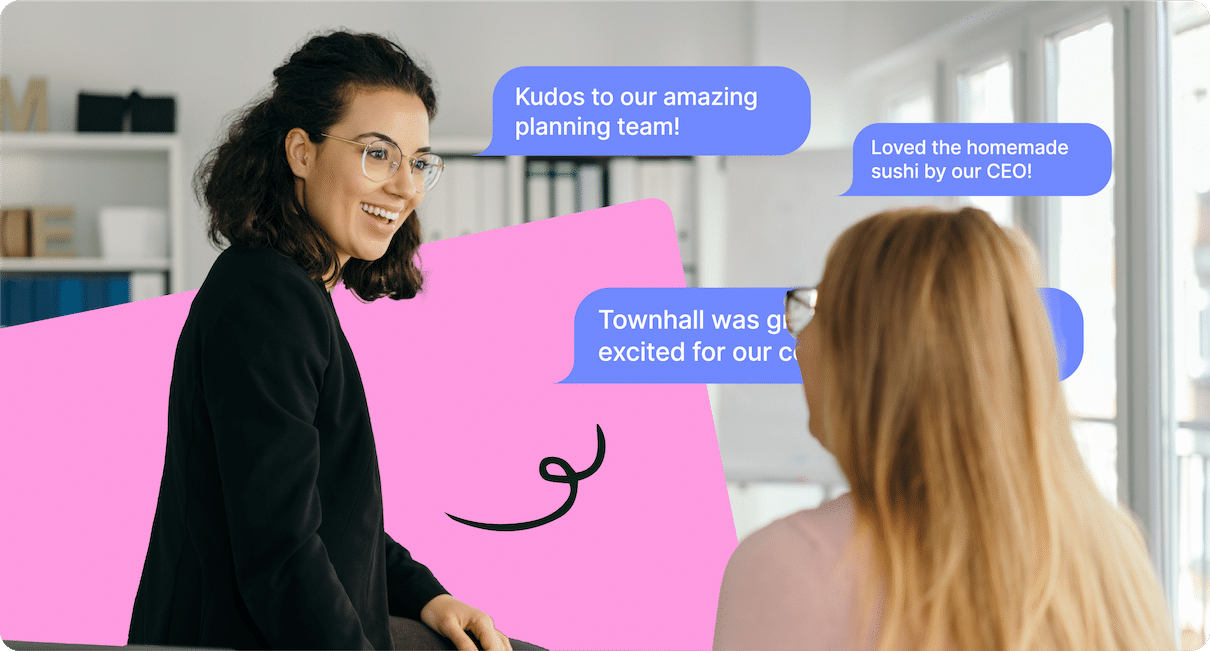Employee feedback is more than just a box to check—it’s a powerful tool for growth, engagement, and performance. However, collecting employee feedback at the right time using a modern internal comms tool makes all the difference. Read on as we share real employee feedback examples and how to use them!
Clear feedback sets expectations and helps managers and employees learn from mistakes. Whether it’s through surveys, one-on-one chats, performance reviews, or even casual conversations when companies listen and take action, they’re not just addressing issues—they’re building a more motivated and engaged workforce.
But, what about employees who don’t want to hear feedback? It’s a tough spot, but ignoring it only creates bigger challenges.
This is why we’ve compiled 10 impactful employee feedback examples to navigate open dialogue with confidence. Whether you’re recognizing a job well done or guiding someone toward improvement, these examples will empower you to communicate effectively and create a culture of continuous development.
Book a demo to see what you can do with ContactMonkey’s employee survey and feedback features – add pulse surveys, eNPS surveys, custom polls, star ratings, emoji reactions and more to your emails!
Take a self-guided tour of ContactMonkey
See how our key features can streamline your internal communications.
Take product tour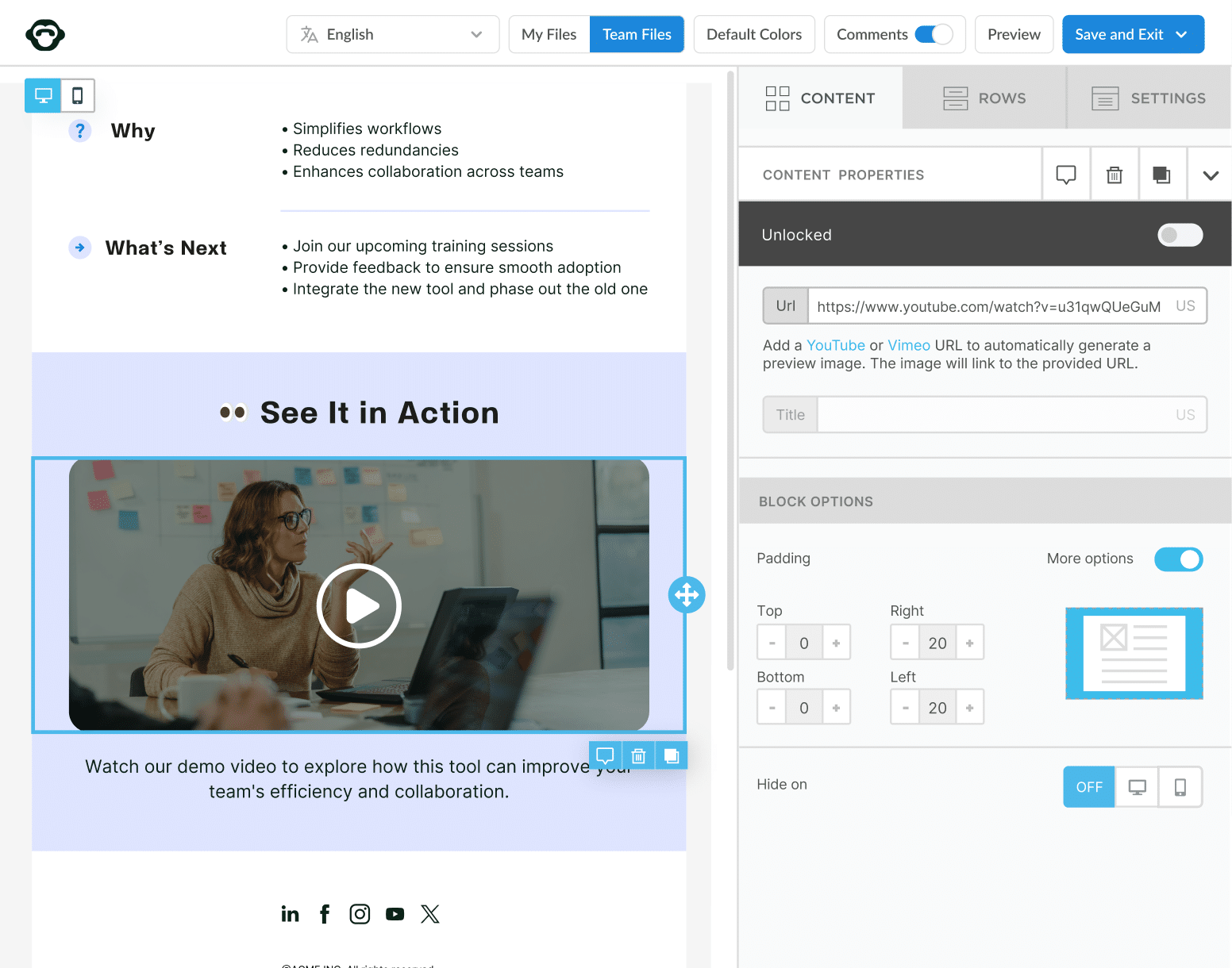
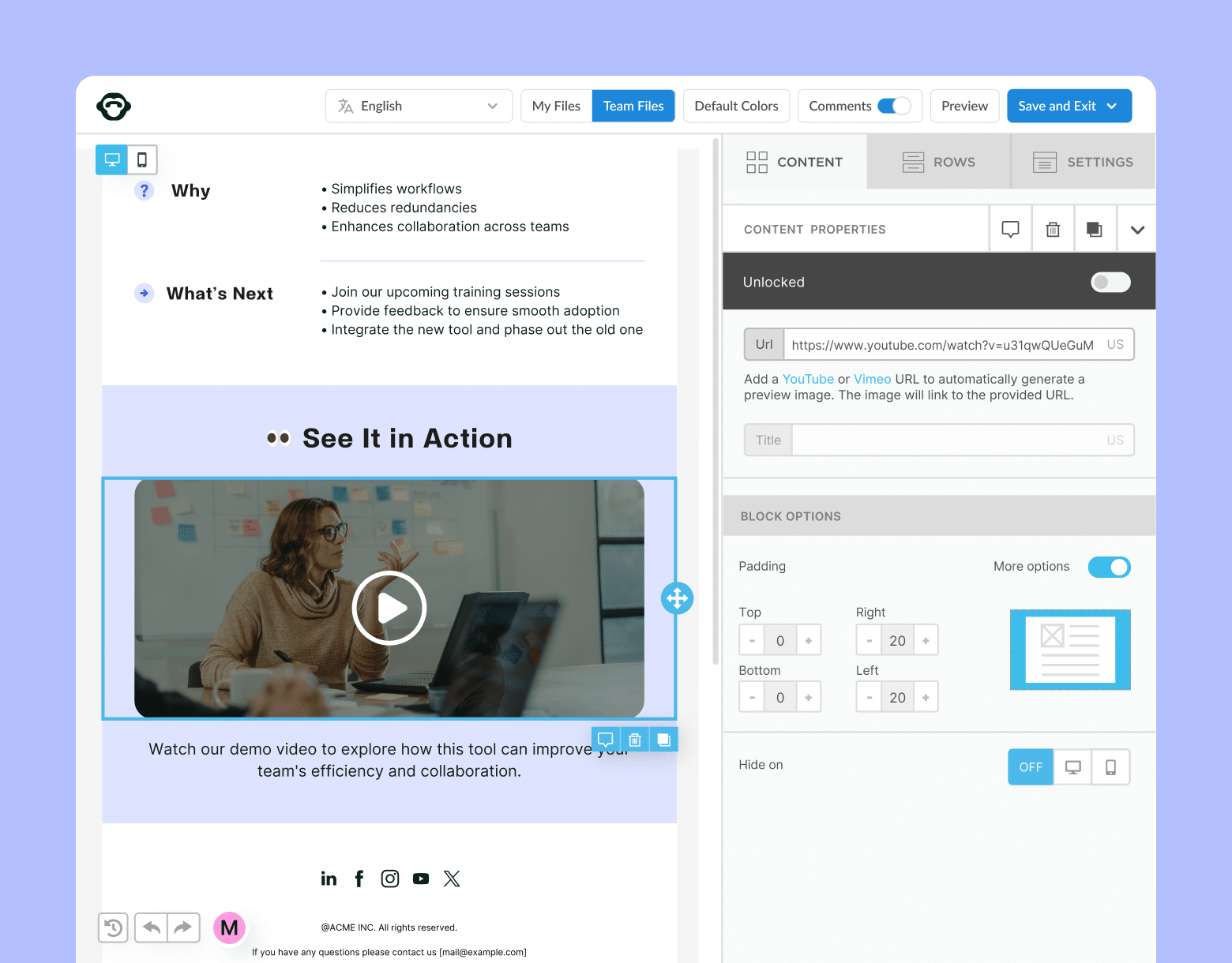
What Is Employee Feedback?
Employee feedback is like the secret ingredient that keeps a workplace thriving. Think of it as a dialogue between employees and their managers, peers, or the entire organization—a chance to speak up about everything from daily tasks and performance to team dynamics and leadership style.
But, it’s not just about dishing out criticism.
So, what’s the main goal? To direct staff towards practices that align their performance with organizational objectives—enhancing productivity and workplace effectiveness. Discover when and why you should set up employee feedback loops using employee engagement software like ContactMonkey to measure employee feedback over time.
Why is Employee Feedback Important?
Employee feedback is important because it lets staff know where they stand and how they could do better.
When it’s thoughtfully delivered, employee feedback empowers employees to excel at their jobs. It also improves bonds between staff and management while opening room for a fluid two-way feedback stream.
And there are additional benefits to consider. For starters, effective employee feedback is directly linked to higher employee engagement, productivity, and employee satisfaction.
When the right feedback is given at the right time and in the right way, it can have incredibly positive long-term effects on employee performance, job satisfaction, and overall business outcomes.
But, before we dive into our best employee feedback examples, let’s dive into the key components of effective feedback.
How to Give Effective Employee Feedback
There’s no one-size-fits-all approach to giving feedback to employees. You’ll have to take into consideration the context in which you’re giving feedback, the severity of the situation, and the communication style that resonates best with your employees. According to Gallup, effective feedback has an expiration date, which is why it must be frequent and timely.
Here are some best practices you should keep in mind when providing feedback – regardless of context:
- Be specific: give examples of situations, actions, and outcomes to back up your feedback.
- Show empathy: mistakes happen. Showing that you understand and want to find solutions together will ensure that employees are responsive rather than defensive to your feedback.
- Propose solutions: this is one of the main goals of employee feedback and shows that your objective is not to criticize but to make improvements.
- Listen to employee input: your employees may have suggestions for how you can help them do better or resources they’ll need to improve. Use ContactMonkey’s employee pulse survey software to embed surveys right into your email newsletter.
We’ve incorporated these best practices in our list of effective employee feedback examples.
Start two-way conversations and employee feedback loops
Learn how to engage staff with pulse surveys, content ratings and reactions, custom polls, and more. Ready to send modern emails?
See engagement features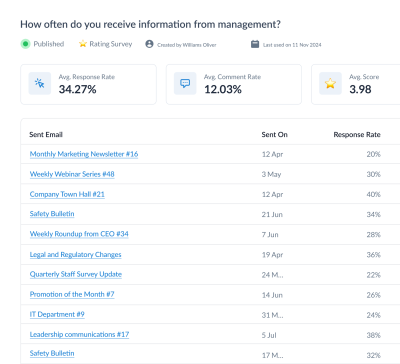
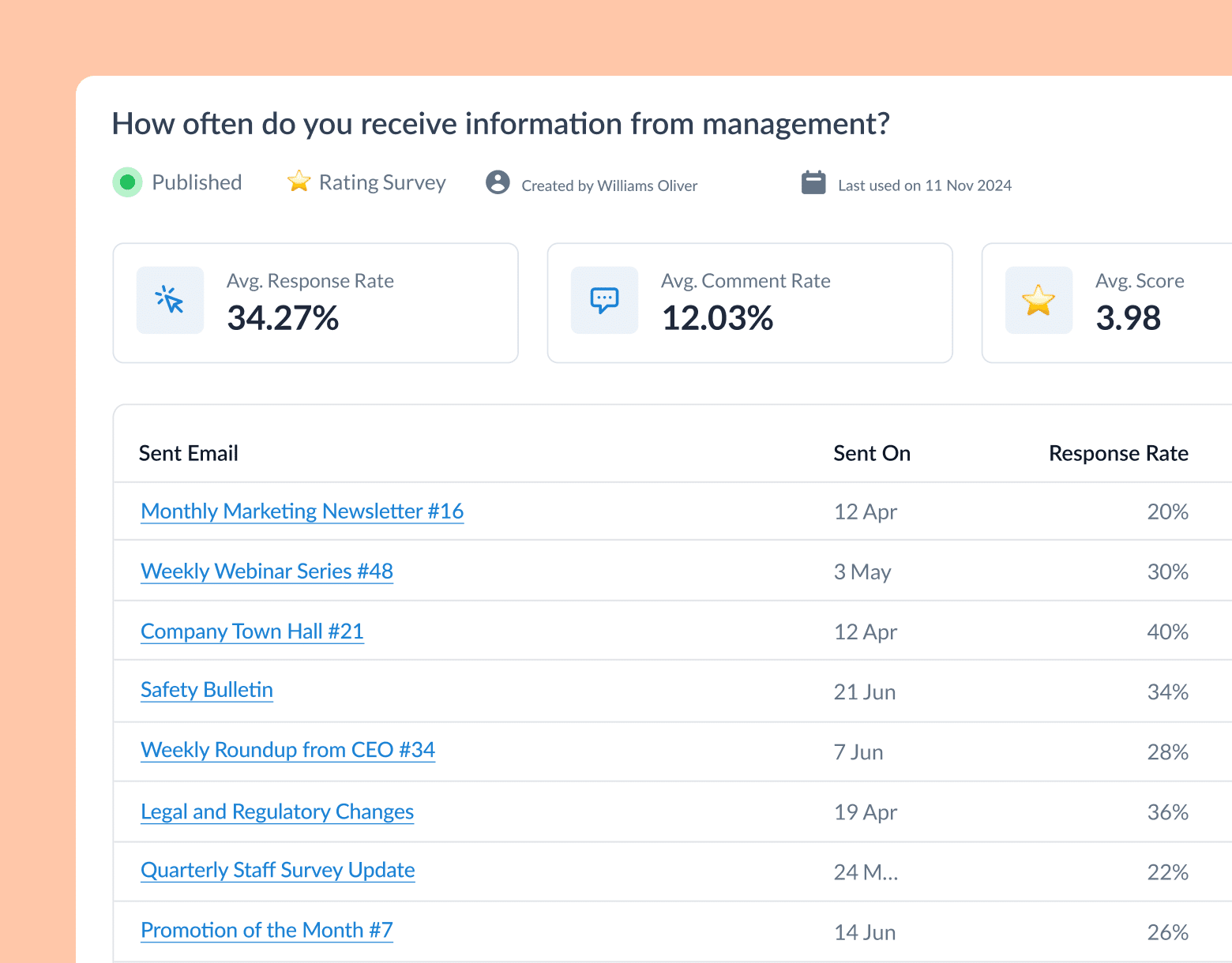
10 Types of Employee Feedback With Examples
Now that we know the core components of effective feedback, let’s look at some examples of employee feedback that can help guide managers.
Think of these examples as templates for the type of feedback to give to your staff. Remember—tailor the employee feedback examples to your specific workplace context and situation.
1. Positive employee feedback
Positive feedback is when employees are recognized and appreciated for their achievements at work. It’s about highlighting what’s going well and reinforcing those actions or attitudes, creating a culture of encouragement and motivation. By celebrating wins — big or small — positive feedback boosts morale, builds confidence, and inspires continued excellence within the team. Measuring employee happiness in the workplace is the key to a thriving organization.
Here are some positive employee feedback examples:
Scenario: An employee performing well at a specific task
How to address: “You did an amazing job with the LIVE webinar yesterday! Our participant survey is showing some awesome feedback. Thanks so much for all your hard work – I appreciate all your efforts in putting this together and ensuring that everything ran smoothly.”
Planning for the future: N/A
2. Constructive employee feedback
Constructive feedback is helpful advice given to an employee that highlights areas for growth and improvement. It provides specific, actionable suggestions to support the employee’s development while maintaining a supportive and encouraging tone.
For instance, try the feedback sandwich method—a simple, balanced approach to giving feedback. Imagine it like making a burger: you start with a positive comment (the top bun), follow up with constructive criticism (the filling), and finish with another positive remark (the bottom bun). This method softens the delivery, making it easier for the recipient to digest the feedback and stay motivated to improve.
Here are some constructive employee feedback examples:
Scenario: Improving attention to detail feedback
How to address: “Your reports are always thorough and well-organized, which is great for the team. However, I noticed a few small errors in the latest one, like misaligned tables and some data points that didn’t match.”
Planning for the future: “Double-checking before submission would really polish it. Overall, your work is strong, and with a bit more attention to detail, it’ll be even more impressive.”
Check out the different types of employee surveys for more inspiration here.
Watch ContactMonkey LIVE in action
Join live demo
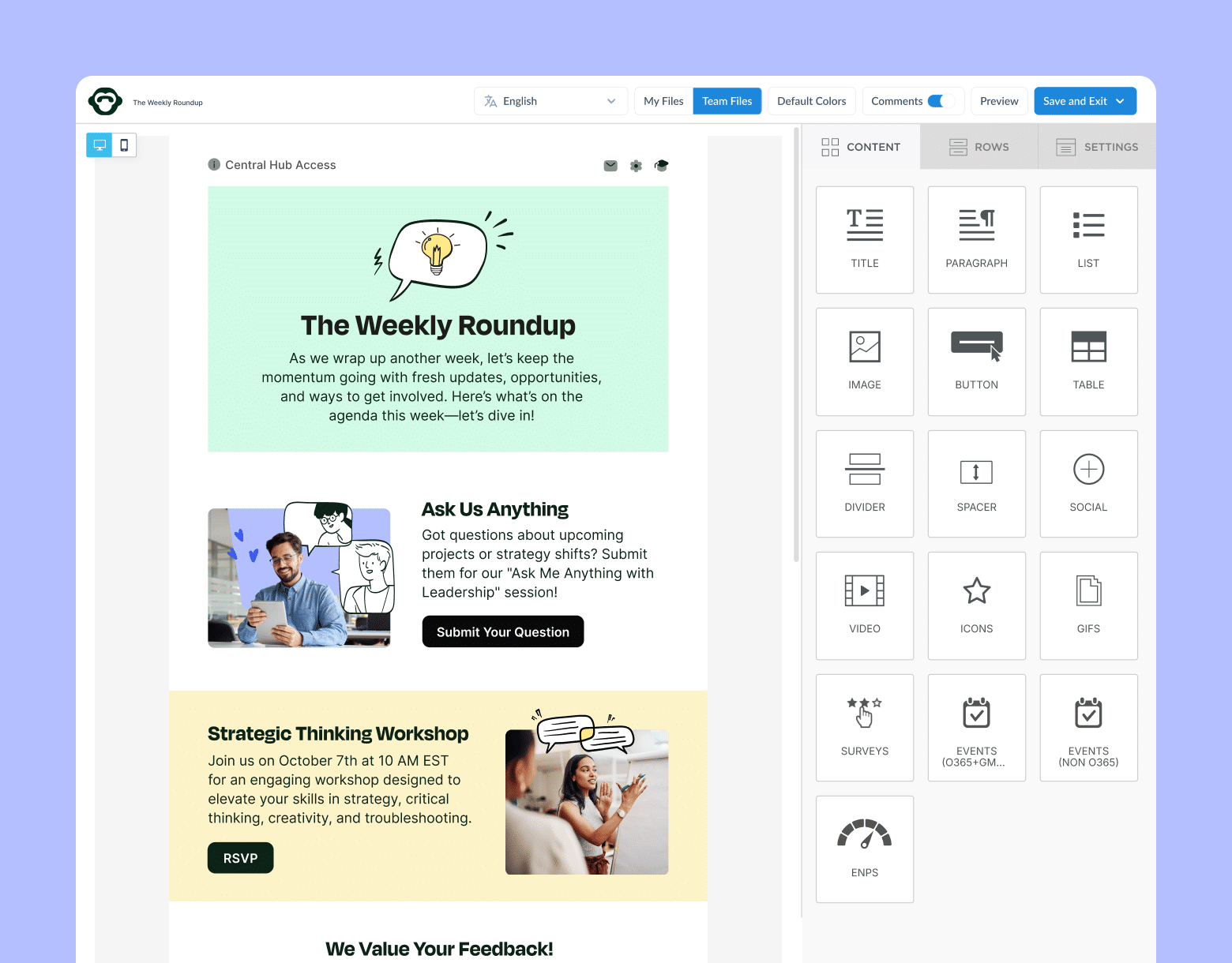
3. Negative employee feedback
Negative feedback in the workplace refers to criticism or comments provided to an employee regarding their performance, behavior, or actions that did not meet expectations or standards. However, it can demoralize and lead to frustration, as it highlights problems without suggesting solutions. While it’s meant to help them improve, if it’s not handled well, it can feel discouraging and hurt employee motivation—leading to employee disengagement in the future.
Check out our negative employee feedback examples:
Scenario: Missing attention to detail
How to address: “I’ve noticed several errors in the data you’ve submitted over the past few weeks, which have required additional time for corrections. It’s important to double-check your work for accuracy to prevent these mistakes.”
Planning for the future: “Please focus on reviewing your data carefully before submission to ensure we maintain our quality standards.”
4. Coaching and career employee feedback
Instead of simply pointing out mistakes, coaching and career feedback help employees understand their strengths and areas for improvement—offering actionable steps to achieve better outcomes. Coaching feedback encourages reflection and promotes problem-solving skills by framing feedback as a learning opportunity.
Scenario: Skill enhancement feedback
How to address: “We see that you have strong presentation skills, but to enhance your impact, consider focusing more on storytelling techniques to engage your audience.”
Planning for the future: “Attending a workshop on public speaking could further refine this strength and help you in future leadership roles.”
Check out our post and learn how to collect employee feedback here. And, to take your results to the next level, read how to improve employee feedback.
5. Recognition employee feedback
Appreciation and recognition feedback is slightly different to positive feedback as it’s more like a standing ovation. It acknowledges bigger achievements, long-term contributions, or exceptional effort—like “Your leadership on this project has made a real impact on the team.” It’s about celebrating the bigger picture and making employees feel valued.
Here’s an example of positive employee feedback that demonstrates appreciation:
Scenario: Recognizing going above and beyond
“I’m so impressed by the extra effort you put in during the recent product launch. You stayed late, tackled unexpected challenges, and kept the team motivated throughout the process. Your hard work and dedication made a significant impact, and we couldn’t have achieved this success without you. Thank you for going the extra mile!”
Planning for the future: N/A
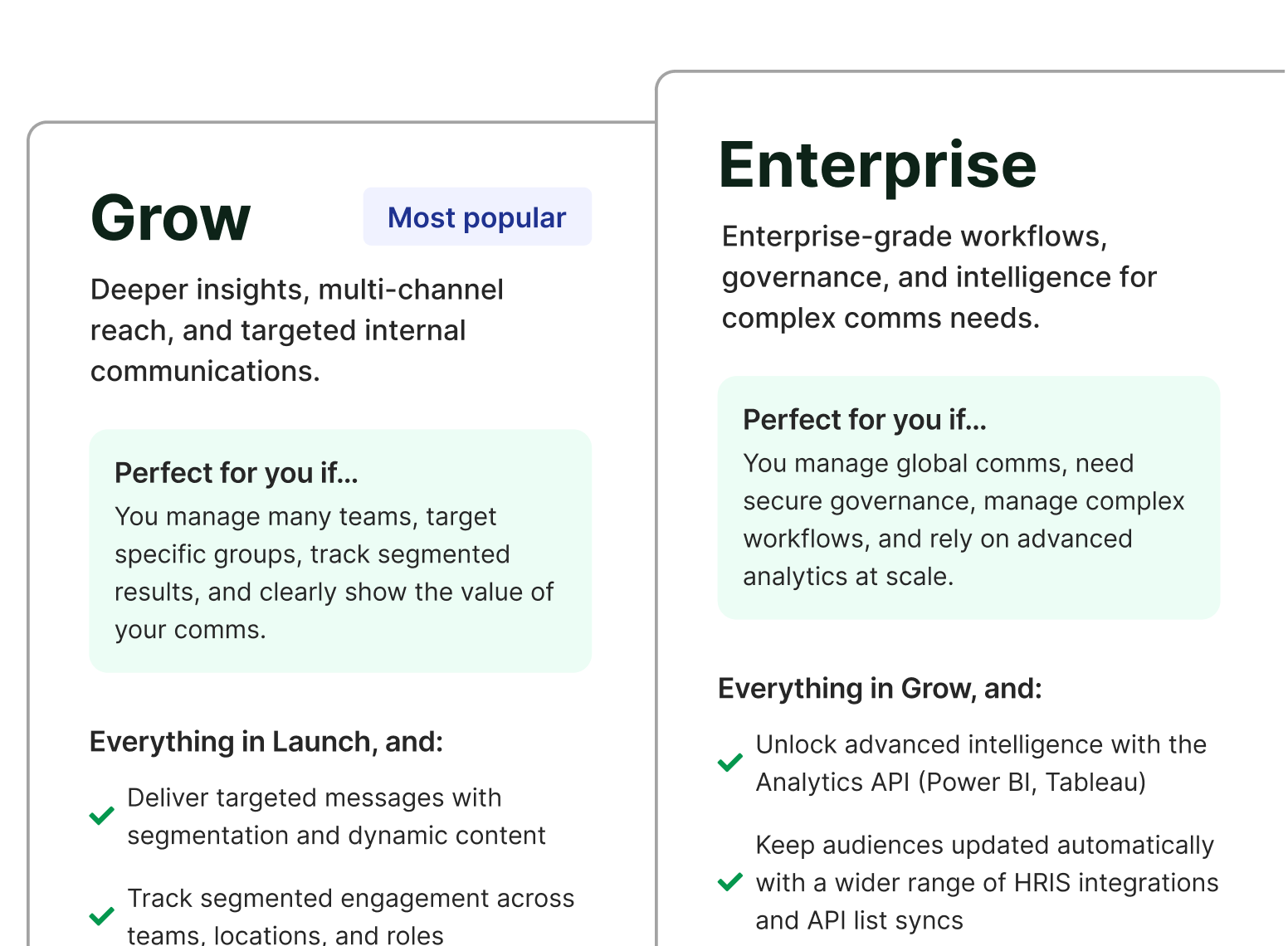
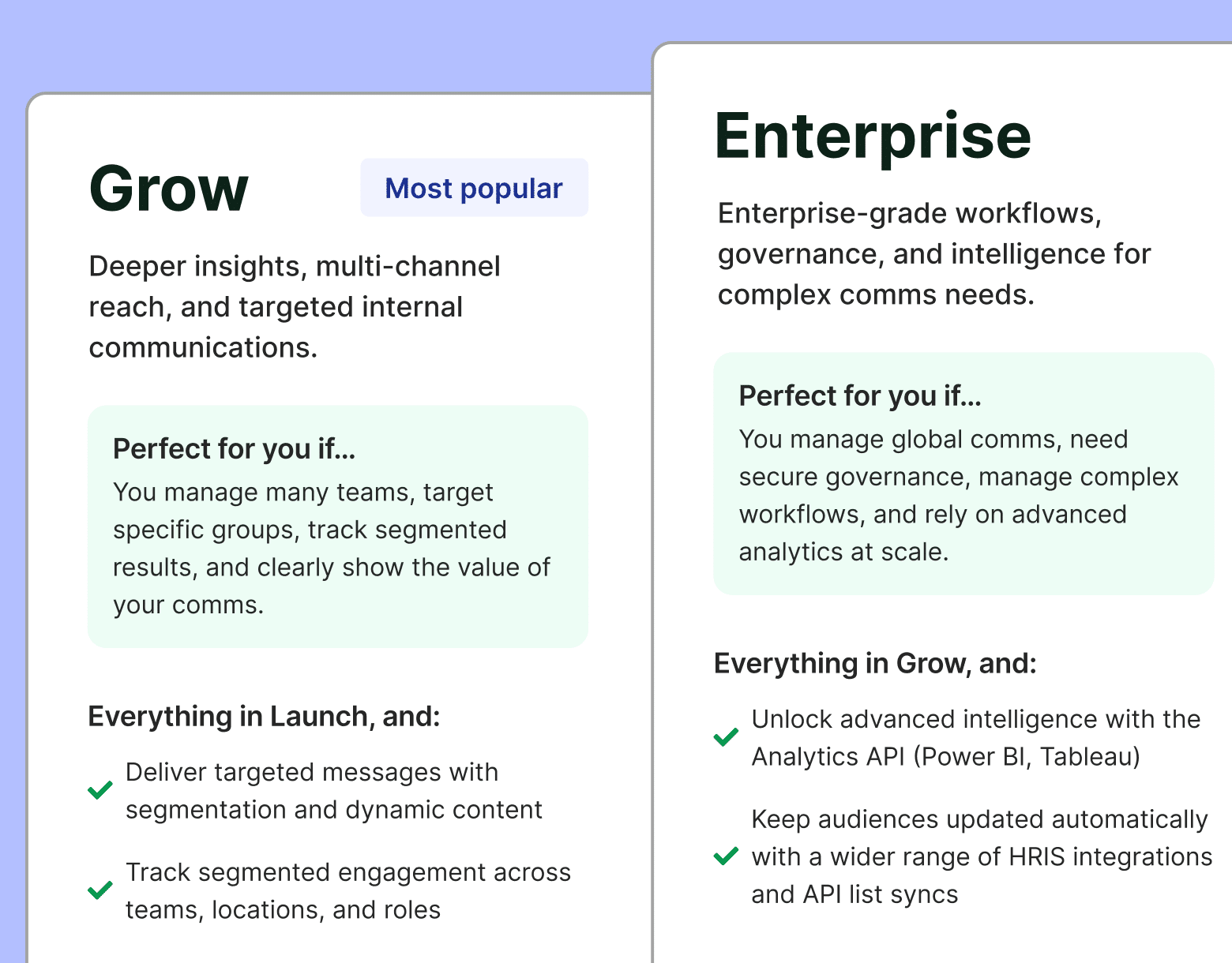
6. Upward employee feedback to management
Upward feedback is a type of feedback where employees provide constructive insights and evaluations to their managers or supervisors. It allows team members to share their perspectives on leadership, communication, and management style. Upward feedback helps improve management practices and promotes a more transparent workplace culture.
Scenario: Discussing management’s decision-making
How to address: “I wanted to share some feedback regarding our decision-making process.”
Planning for the future: “I think it would help if we were given more opportunities to provide input before final decisions are made, especially on issues that directly affect our work. This could enhance our sense of ownership and lead to better results for the team.”
If you’re looking to gain insights into how your employee satisfaction and loyalty in the workplace, use an Employee Net Promoter Score (eNPS) survey in your internal comms. You can also turn on anonymous commenting to gather anonymous feedback on more sensitive topics—making your employees feel more comfortable to respond honestly.
For more survey inspiration, check out our Employee Net Promoter Score survey questions here.
7. Formal employee feedback
Formal feedback is a structured, planned, and documented type of feedback provided through different channels, like performance reviews, employee evaluations, or scheduled meetings. This feedback is usually aligned with organizational goals, policies, and procedures. It’s also used to assess performance, set objectives, and provide clear expectations for growth and improvement.
Check out our formal employee feedback example:
Scenario: Improving time management
How to address: “During this performance review period, you have consistently met your sales targets and demonstrated strong customer relationship skills. However, there is an opportunity to improve your time management by prioritizing tasks more effectively.
Planning for the future: “Setting clearer daily goals could help you maintain focus and increase productivity.”
Another effective way to gather employee feedback is with a 360 performance review. It’s a comprehensive look into an employee’s performance from multiple sources, including peers, direct reports, and supervisors. With ContactMonkey, segment your internal email lists with our list management tool. This allows you to send emails and employee surveys to different audiences so you can gather the right feedback from the right people.
Create and send employee surveys for feedback
Engage staff with pulse surveys, eNPS surveys, reusable surveys, custom polls, and more. Ready to send modern emails?
Explore survey features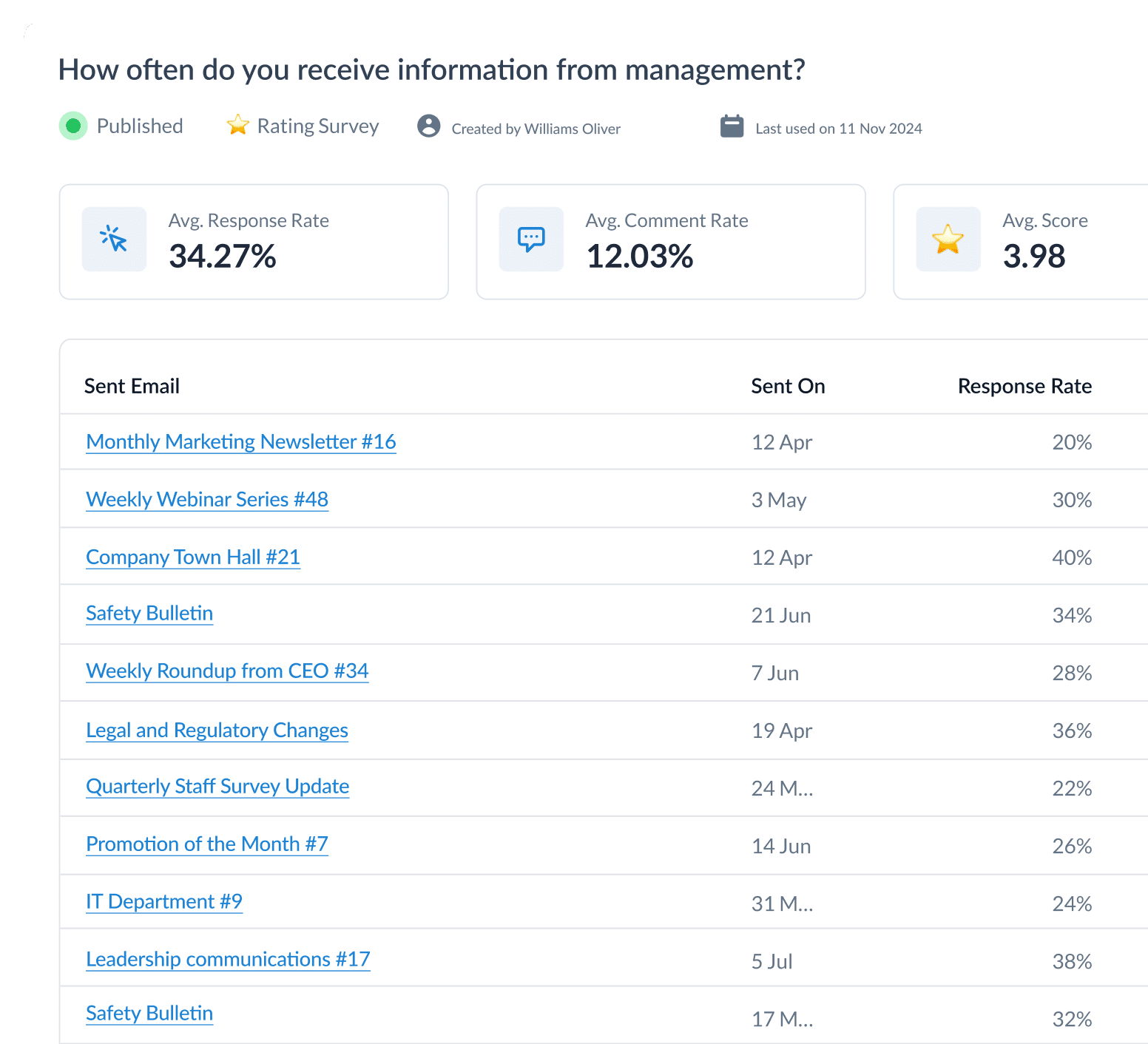

8. Informal employee feedback
Informal feedback in the workplace is spontaneous, real-time feedback given during everyday interactions, like quick conversations, impromptu check-ins, or casual remarks. It’s typically not structured nor documented—focusing on immediate observations or behaviors.
Here’s a good informal employee feedback example:
Scenario: Handling a difficult customer
How to address it: “Hey! I noticed how you handled that difficult customer earlier today. You stayed calm and patient, which really helped de-escalate the situation. Great job – keep it up!”
Planning for the future: N/A
Read our post for a deeper look into why feedback is important in an organization here.
9. Peer-to-peer employee feedback
Peer feedback in the workplace is given by employees to their colleagues at the same organizational level. It focuses on providing constructive insights about their behaviors, skills, and contributions–often related to teamwork, collaboration, and interpersonal interactions. Peer feedback encourages mutual support and open communication within teams.
Let’s take a look at some peer employee feedback examples:
Scenario #1: Offering feedback on presentation skills
How to address it: “Your presentation had a lot of valuable information.”
Planning for the future: “I think it could be even more effective if you slowed down a bit and engaged with the audience more. Pausing for questions or adding some visuals might help keep everyone more involved.”
10. Feedforward employee feedback
Feedforward feedback is a type of feedback focused on future actions and development rather than past performance. Instead of critiquing what an employee did wrong or could have done better, feedforward feedback provides constructive suggestions, advice, and guidance for how they can improve and succeed in future situations.
Here’s an employee feedback example for development you can try:
Scenario #1: Improving presentation skills
How to address it: “In your next presentation, try using more visuals to highlight key points.”
Planning for the future: “This can help make complex information clearer and keep the audience engaged throughout. Practicing with a colleague beforehand might also help you feel more confident and prepared.”
7 ways to get honest feedback from employee surveys
Will your workforce tell the truth? Foster trust and openness with your employee using these tips.
Download tips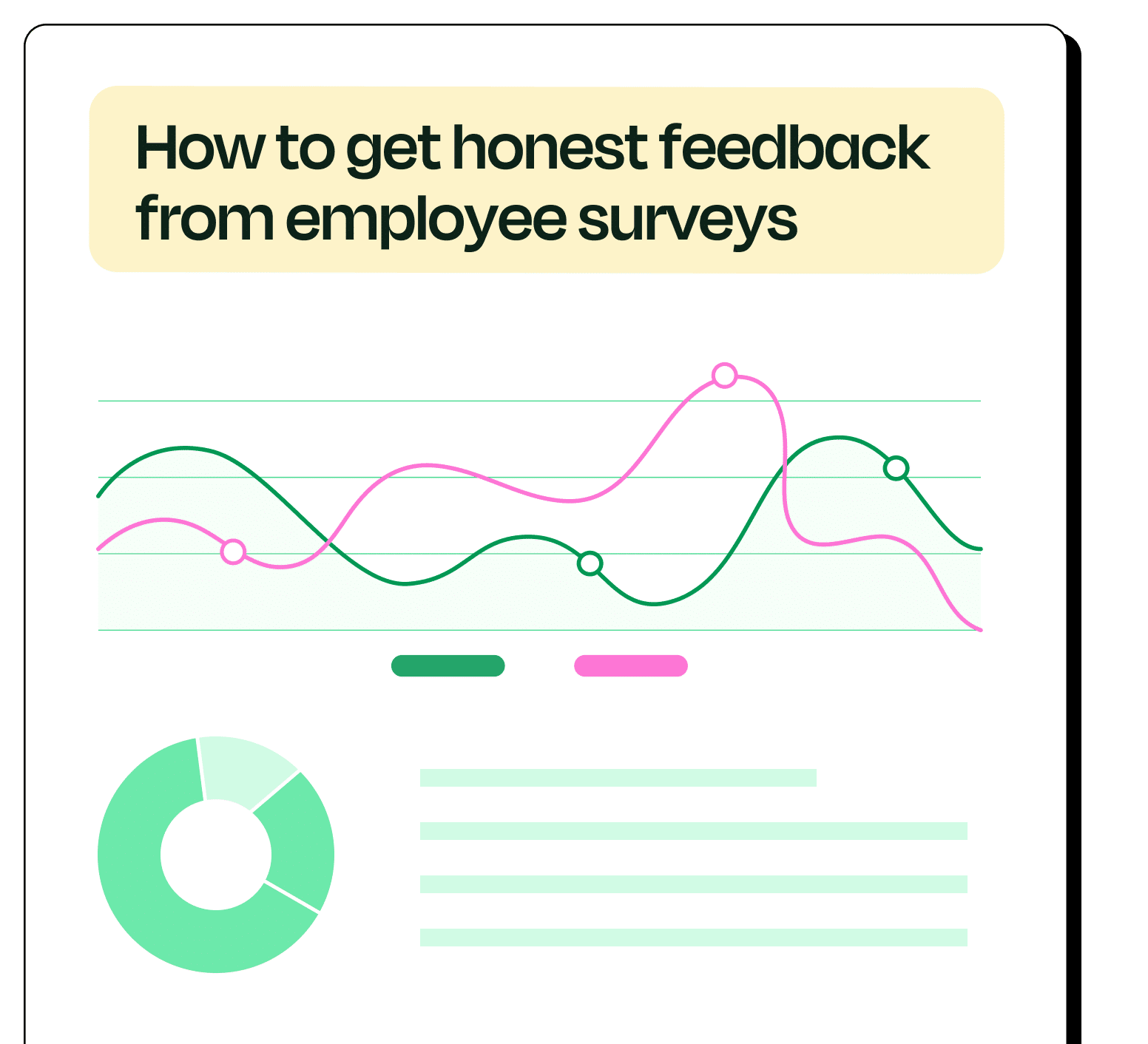
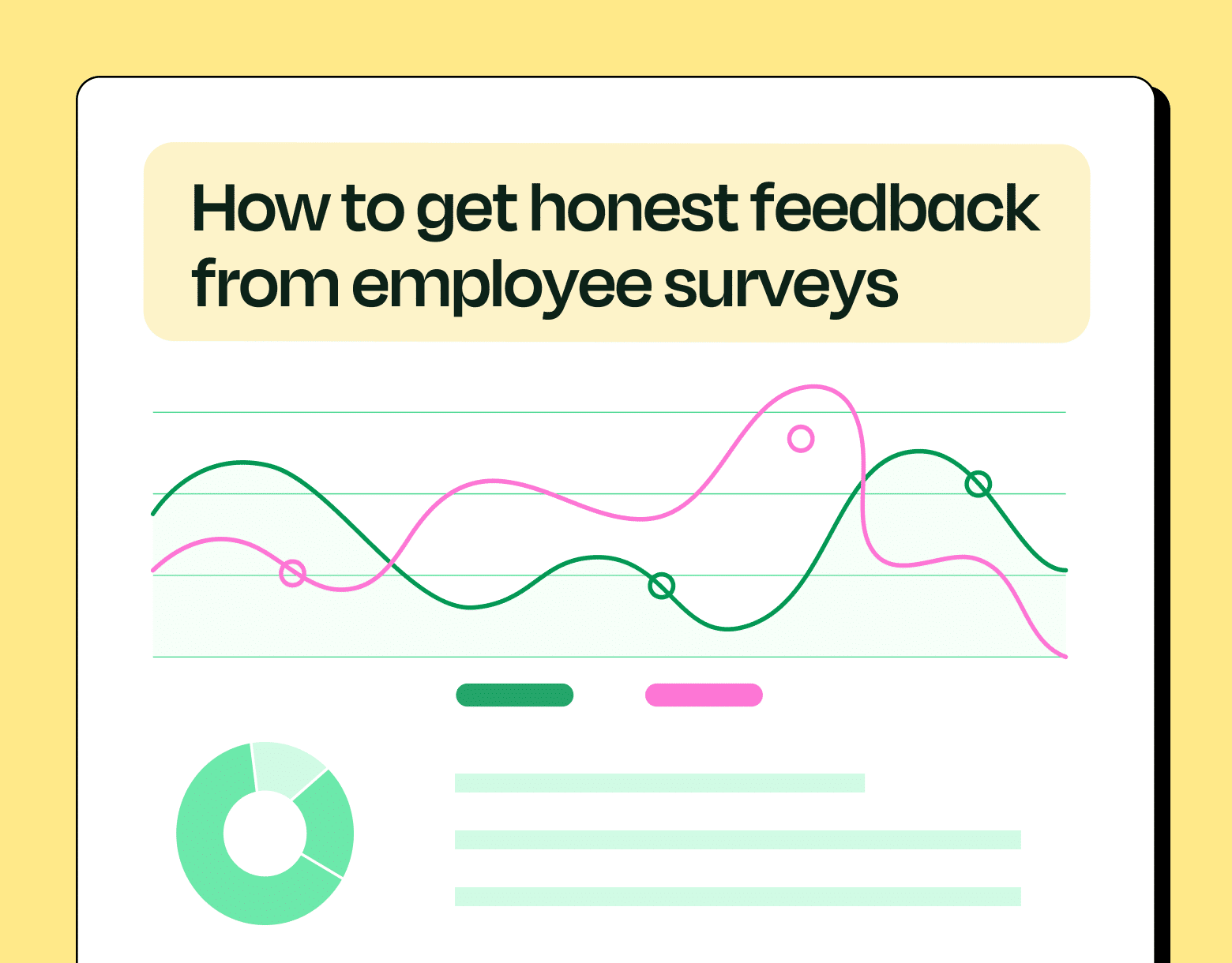
How ContactMonkey Can Help You Gather Employee Feedback
To drive meaningful results from employee feedback, it’s crucial not only to ask for input but also to act on it.
With ContactMonkey’s employee engagement tool, gathering feedback becomes effortless—right through your employee newsletters! Within your newsletter, you can choose from a variety of interactive survey options like star ratings, emoji reactions, like buttons, or employee Net Promoter Score (eNPS). Simply pick your favorite survey style from the sidebar and drag it right into your employee feedback email. Creating similar emails over and over is a major time suck. With recurring emails, you can automate regular messages and skip the hassle of starting from scratch every time.
Want more honest and detailed insights? Turn on the anonymous comments feature in the top-right corner of the email template builder for candid feedback from your team.
For expert tips on maximizing engagement, check out this list of the best employee engagement examples.
No matter which feedback method you choose, ContactMonkey’s employee feedback software makes tracking responses a breeze with its detailed email analytics. You’ll gain clear insights into the areas where your employees need support and can provide the right resources to help them succeed. Plus, by taking action on their feedback, you’re showing employees that their input truly matters.
When it’s time for you to provide feedback, your team will already understand it’s all part of a continuous improvement strategy—not a sign of trouble.
Need feedback from a specific group? Our list management feature allows you to create custom email lists and send targeted surveys to different employee segments. With seamless integration into your HRIS, like Workday and ADP, or Azure Active Directory, your email lists will automatically update as employees come and go, keeping your communications efficient and accurate.
Learn more about how employee feedback platforms can be beneficial to your company.
Make Employee Feedback Straightforward
When you master the art of delivering feedback, you can address challenges swiftly and celebrate achievements just as quickly. The key? Always keep your feedback respectful, solution-focused, and empathetic. By using the employee feedback examples from this post, you’ll be equipped to offer meaningful input and foster smooth, open feedback channels that drive real results.
With great tools like ContactMonkey, employers can get the necessary insights to provide timely feedback. They’ll also foster an environment where feedback is the norm. Book your demo to discover how ContactMonkey can help you tap into the full benefits of employee feedback at your workplace.



